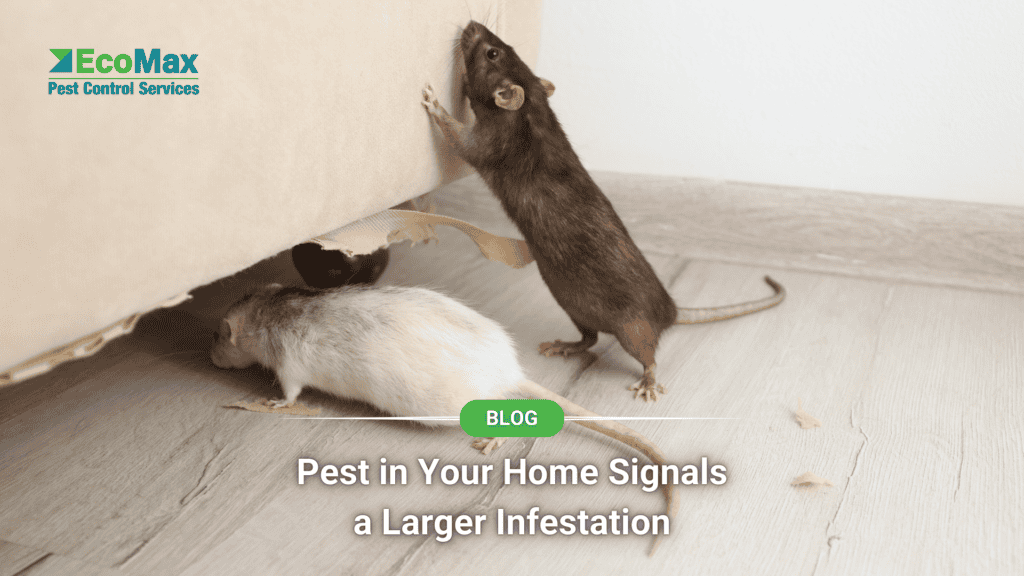Spotting a single pest inside your home might seem like a minor issue, but it often indicates a much bigger problem. Many pests, including cockroaches, rodents, and termites, are experts at staying hidden. By the time you see one, there’s a high chance that an infestation is already developing in areas you can’t see.
Pests invade homes in search of food, water, and shelter, taking advantage of small openings, moisture issues, and unsealed food sources. Even a small number of pests can multiply rapidly, leading to structural damage, contamination, and health risks. Understanding why pests appear, recognizing early signs of an infestation, and taking prompt action can help prevent a serious problem.
Why One Pest Means More
Pests rarely travel alone. They’re social, fast-breeding, and experts at staying hidden. Here’s a breakdown of common pests and why a single sighting spells trouble:
1. Cockroaches: The Nighttime Ninjas
- Behavior: Cockroaches avoid light and scatter when exposed. Spotting one in daylight often means overcrowding forces them into the open.
- Reproduction: A single female German cockroach can produce 30,000 offspring in a year. They leave pheromone trails to guide others to food and shelter.
- Risks: They spread salmonella, trigger asthma, and taint food with bacteria.
2. Rodents: The Silent Destroyers
- Behavior: Mice and rats are nocturnal. A daytime sighting suggests a large population competing for resources.
- Reproduction: One female mouse births 5-10 pups every 3 weeks. They gnaw through wires, insulation, and even PVC pipes.
- Risks: Rodent droppings spread hantavirus, and their urine corrodes building materials.
3. Termites: The Stealthy Architects
- Behavior: Termites work 24/7, eating wood from the inside out. “Swarmers” (winged termites) emerge when a colony is mature—often after years of hidden damage.
- Reproduction: A queen termite lays 30,000 eggs daily. Subterranean species build mud tubes to infiltrate foundations.
- Risks: Termites cause $5 billion in U.S. property damage annually, often excluded from homeowners’ insurance.
Lesser-Known Threats:
- Bed Bugs: Hitchhike on luggage or furniture. A single pregnant female can infest an entire room.
- Carpenter Ants: Tunnel through damp wood, weakening structures.
How Pests Sneak In
Pests exploit vulnerabilities you might overlook. Here’s how they breach your defenses:
1. Cracks & Gaps: The Invisible Highways
- Foundation Cracks: Hairline fractures in concrete or brick let ants, spiders, and rodents slip through.
- Window/Door Gaps: Gaps as thin as 1/16 inch allow entry. Install weatherproof seal strips.
- Utility Lines: Gaps around pipes, vents, or AC lines are prime entry points.
2. Food Sources: The Pest Buffet
- Unsealed Pantry Items: Flour, cereal, and pet food attract pantry moths and beetles.
- Trash & Recycling: Fruit flies and rodents feast on organic waste. Use airtight bins to cut off access.
- Crumbs & Spills: A single sugar spill lures ants within hours.
3. Moisture: The Pest Oasis
- Leaky Pipes: Dripping faucets create ideal breeding grounds for cockroaches and silverfish.
- Clogged Gutters: Standing water attracts mosquitoes and termites.
- Basement Humidity: Keep dampness below 50% with solutions from Eco Max
4. Landscaping & Clutter
- Overgrown Shrubs: Branches touching your home act as bridges for ants and rodents.
- Firewood Storage: Stacking wood against your house invites termites and spiders.
- Cardboard Boxes: Roaches and silverfish thrive in stored clutter.
Signs of a Hidden Infestation
Pests leave subtle traces long before you see them. Watch for these red flags:
1. Droppings & Tracks
- Mouse Droppings: Small, pellet-like, often near walls.
- Cockroach Feces: Resemble coffee grounds or black pepper.
- Termite Frass: Wood-colored pellets near baseboards.
2. Unusual Odors
- Musty Smells: Indicate termites or mold.
- Ammonia: A sharp, urine-like scent signals rodents.
- Sweet or Oily: Bed bugs emit a coriander-like odor.
3. Physical Damage
- Gnaw Marks: On wires, furniture, or food packaging.
- Mud Tubes: Pencil-sized tunnels on walls (termites).
- Hollow Wood: Tap surfaces—termites eat from the inside out.
4. Sounds & Movement
- Scratching Noises: In walls or attics at night.
- Rustling: In insulation or ductwork.
Pro Tip: For advanced monitoring tools, Visit Eco Max to smart pest detection.
What to Do Immediately After Spotting a Pest
Act fast to prevent a full-blown infestation:
Step 1: Inspect Thoroughly
- Hotspots: Check under sinks, behind appliances, and in basements.
- Tools: Use a flashlight and magnifying glass to spot eggs or larvae.
Step 2: Eliminate Food & Water Sources
- Deep Clean: Vacuum crumbs, wipe spills, and store food in airtight containers.
- Fix Leaks: Repair dripping faucets and install leak detectors.
Step 3: Seal Entry Points
- DIY Solutions: Apply expandable foam sealant to gaps around pipes.
- Professional Grade: For large cracks, use copper mesh or steel wool (rodents can’t chew through).
Step 4: Deploy Monitoring Tools
- Traps: Use non-toxic glue boards to track pest movement.
- Sensors: Install wireless alerts in high-risk zones.
Step 5: Call a Professional
- When to Call: If you find nests, hear persistent noises, or spot multiple pests.
- What to Expect: Pros use thermal imaging, moisture meters, and targeted treatments.
Final Thoughts
A single pest is a distress signal from your home. Termites can devour a 2×4 plank in months, while mice gnaw through electrical wiring, risking fires. Waiting “to see if more appear” is a gamble with your health and safety.

